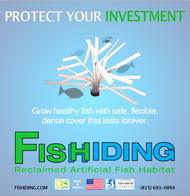The Science Behind Fishiding Artificial Fish Habitat-Time Lapse Video (Part 2 of 10)
Posted by Ewald.Engbretson on 13th Nov 2018
Part Two: Integration
There’s no such thing as a single artificial habitat that does it all. That’s why Fishiding habitat comes in various and many different design models. Each habitat model is conceived to achieve a specific purpose or to serve in a specific range of depth. In this time-lapse video, you see several of our “Bunker” models combined with two “Small Stake” units. Every Fishiding habitat is designed to mimic something in nature. When it comes to artificial habitat, our research shows that fish prefer complex designs that resemble natural elements like macrophytes or coarse woody habitat; they shy away from assemblages that look foreign and out of place. Since they mimic cattails, the “Bunker” and “Small Stake” models are best in shallow littoral zones where fish would naturally expect to find such environments. In these locations, they get plenty of sunlight and quickly grow algae. This gives them a fuller and bushier appearance and helps to create more caverns in the interior core that small fish use for concealment. Every Fishiding habitat model provides tight nooks and crannies completely inaccessible to larger fish; this feature ensures genuine protection for juvenile fish.
This video shows the seamless integration of the habitat and the Chara that grows on the floor of the lake. It’s always desirable to combine artificial habitat with natural elements whenever it’s possible. When you marry the right artificial structure to natural components, it becomes part of the mosaic of the lakescape instead of intruding into or disrupting the ecology. Even in lakes devoid of aquatic vegetation, other naturally occurring elements can usually be incorporated to add dynamism to the structure.
Centrachids are particular fond of these habitats and will orbit them persistently—in exactly the same way they relate to cattails in the lake. For young of the year fish, these structures are homes in a literal sense. They provide essential cover, harbor invertebrates, and give the young fish a good head start. At this time, the other types of artificial habitat available simply lack the complexity to provide these vital benefits. These habitats are often spindly exposed frames and possess nothing that can be used for concealment or refuge. Effective fish habitat must have a labyrinth of pockets and retreats that are completely inaccessible to predators.
The most impressive part of this video is what you can’t see. Nearby, and just out of camera range, is a wide assortment of brush piles, coarse woody habitat, rich beds of aquatic plants, and other elements that nature abundantly provides in healthy, vibrant, natural lakes. Even with this Camelot so near, fish still deem our Fishiding artificial habitat worthy of attention. We don’t maintain that artificial habitat is better than natural habitat, but by trying to mimic nature in our designs, we demonstrate that it’s possible to create credible surrogates.
Designing and building effective fish habitat is a genuine science. It’s still in its infancy, but we’re learning a great deal every day about the nuances of design and deployment. With today’s deep interest in artificial fish habitat, we’re eager to share our findings with fisheries professionals who want to learn more. We’ve come a long way since the days of throwing discarded Christmas trees into our lakes and calling it a day. Stay tuned. In this continuing series, we’ll show you more underwater video of how fish utilize artificial habitat and reveal why so many popular designs are completely ineffective.
For more information contact David Ewald at https://www.fishiding.com Phone: (815) 693-0894 Email: sales@fishiding.com)



